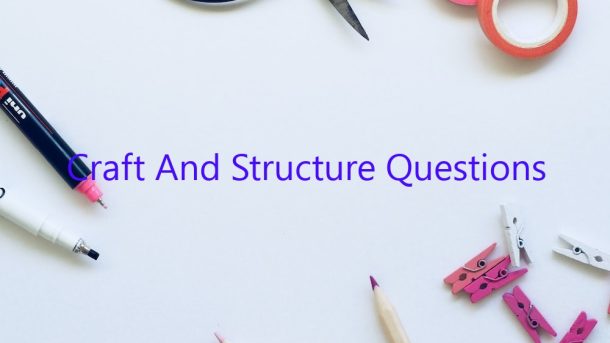craft and structure questions
Craft and structure questions are an important part of the writing process. They can help you to clarify your ideas and to organise your thoughts.
There are two types of craft and structure questions:
1. Questions about the craft of writing:
– What are the different techniques that you can use to create a specific effect?
– How can you use language to create a specific mood or atmosphere?
– What are the different elements that make up a good story or essay?
2. Questions about the structure of writing:
– How should you organise your ideas?
– What is the best way to introduce and develop your arguments?
– How can you use transitions to ensure that your writing is smooth and cohesive?
Craft and structure questions can help you to improve your writing in a number of ways. They can help you to:
– Clarify your ideas
– Organise your thoughts
– Improve your writing style
– Improve your argumentation
– Improve your coherence and cohesion
Contents
What is craft and structure?
Craft and structure are two important elements of writing that work together to create a well-crafted story. Craft is the visible elements of writing that are used to create a desired effect, such as word choice, sentence structure, and imagery. Structure is the invisible elements of writing that help to create a cohesive and effective story. Together, craft and structure create a well-crafted story that is both enjoyable to read and easy to understand.
One of the most important elements of craft is word choice. Good word choice can make your writing more engaging and interesting to read. It can also help to convey your message more effectively. In order to choose the right words, you need to understand the nuances of language and how words can be used to create different effects.
Sentence structure is another important element of craft. Well-constructed sentences can help to create a clear and concise story. They can also be used to create tension or suspense, or to convey emotion. Good sentence structure can also make your writing more interesting to read.
Imagery is another element of craft that can be used to great effect. Well-chosen images can help to transport your readers into your story and make it more engaging. They can also be used to convey emotion or to add depth to your story.
The structure of a story is the invisible framework that holds it together. It includes the plot, the characters, and the setting. It also includes the various techniques that you use to tell your story, such as flashbacks, foreshadowing, and cliffhangers. The structure of a story helps to create a cohesive and effective story.
Craft and structure are two important elements of writing that work together to create a well-crafted story. Craft is the visible elements of writing that are used to create a desired effect, such as word choice, sentence structure, and imagery. Structure is the invisible elements of writing that help to create a cohesive and effective story. Together, craft and structure create a well-crafted story that is both enjoyable to read and easy to understand.
What does analyze craft and structure mean?
What does analyze craft and structure mean?
When a writer is analyzing craft and structure, they are looking at the specific elements that make up a piece of writing. This includes the plot, characterization, setting, and other elements that contribute to the story. By understanding how these elements work together, a writer can create a more well-rounded and effective story.
Additionally, a writer who is analyzing craft and structure is also looking at the way a story is structured. They are examining the way the plot unfolds, the use of flashbacks and other storytelling devices, and the way the ending ties everything together. By understanding how a story is put together, a writer can learn from the successes and failures of other writers and create their own stories that are more likely to be well-received by readers.
What are text dependent questions examples?
Text dependent questions are questions that can be answered only by referring to a specific text. They are used to test a student’s understanding of the text.
There are several types of text dependent questions. One type is the inference question. Inference questions ask the reader to make a deduction based on the text. For example, “According to the text, what is the main reason the protagonist is unhappy?”
Another type of text dependent question is the detail question. Detail questions ask the reader to recall specific information from the text. For example, “According to the text, what is the protagonist’s occupation?”
Another type of text dependent question is the inference-to-the-main-idea question. This type of question asks the reader to identify the main idea of the text and to make a deduction based on that idea. For example, “What is the main idea of the text?”
Text dependent questions are an important part of reading comprehension. They help teachers assess a student’s understanding of the text and help students learn how to focus on the important details in a text.
How do you write a text dependent question?
Text dependent questions are a key part of assessment in many academic disciplines. They are questions that can only be answered by referring to specific text passages, rather than general knowledge or personal experience.
When writing a text dependent question, it is important to keep three things in mind:
1. The question should be based on a specific passage or passages from the text.
2. The question should require students to refer back to the text in order to answer it.
3. The question should not be based on personal opinion or general knowledge.
For example, a question about a text passage might ask students to identify the main idea of the passage, or to explain how the author uses evidence to support their argument.
It is important to keep in mind that text dependent questions should not be used to test students’ understanding of general knowledge or personal experience. Rather, they should be used to test students’ understanding of the text itself.
What is craft and structure Common Core?
Craft and Structure in the Common Core State Standards
One of the main goals of the Common Core State Standards (CCSS) is to ensure that all students have a common understanding of the skills they need to be successful in college and in the workforce. One of the most important aspects of the CCSS is the emphasis on craft and structure.
What is craft and structure? In essence, it is the way in which a writer puts together words to create meaning. The CCSS focus on craft and structure ensures that students learn how to use language effectively and create clear and concise writing.
One of the most important aspects of the CCSS is the focus on academic vocabulary. This focus helps students learn the precise meaning of words and how to use them in a variety of contexts.
The CCSS also emphasize the importance of grammar and Mechanics. Students must learn how to use proper grammar and punctuation to ensure that their writing is clear and error-free.
The focus on craft and structure in the CCSS ensures that students learn the skills they need to be successful in college and in the workforce. It is one of the most important aspects of the CCSS and it is essential that all students have a strong foundation in these skills.
What are the 7 types of text structures?
There are seven types of text structures: sequence, compare and contrast, cause and effect, problem and solution, description, classification, and analogy.
Sequence structures present events in the order in which they occurred. They can be simple or complex, with one or more steps.
Compare and contrast structures compare and contrast two or more items. They can be used to highlight similarities and differences, or to make a judgement.
Cause and effect structures explore the relationships between events. They can show how one event led to another, or how something caused a problem.
Problem and solution structures present a problem and then provide a solution. They can be used to teach or persuade.
Description structures provide a detailed description of an object, event, or process.
Classification structures group items into categories. They can be used to teach or to organise information.
Analogy structures compare two things, often using a metaphor. They can be used to teach or to make a point.
There is no one answer to the question of how to teach author’s craft structure. Every writer is different, and what works for one may not work for another. However, there are a few things that can be done to help teach authors the importance of structure in their writing.
One way to teach author’s craft structure is to start with the basics. Explain to students what structure is and why it is important. Show them examples of well-structured pieces of writing, and point out the ways in which they are effective. Then, have students practice writing using a variety of structures. This can be done in a variety of ways, such as through writing prompts, exercises, or even games.
Another way to teach author’s craft structure is to focus on the different types of structures that can be used in writing. This can include teaching students about the different parts of a story, such as the beginning, middle, and end, and helping them understand how to use these parts effectively. It can also involve teaching about different types of paragraphs, such as the introduction, body, and conclusion, and how to use them to create a well-written piece.
Ultimately, the best way to teach author’s craft structure is by giving students the opportunity to practice. Allow them to experiment with different structures, and help them understand how to use them effectively. This will not only help them learn the importance of structure in writing, but it will also help them become better writers.




